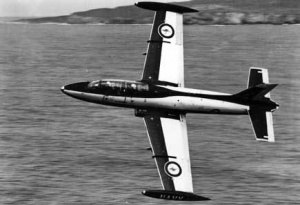August 1965 it was announced that the Aermacchi MB-326 aircraft had been selected as the RAAF’s new training aircraft. Commonly known as the ‘Macchi’ this aircraft was designed with an ‘all through’ jet trainer concept. This concept was being adopted by several air forces at the time as a cost effective training model. The underlying philosophy was for a relatively inexpensive aircraft design capable of training pilots from basic to advanced stages as well as having a secondary attack capability. The RAAF initial order for 75 aircraft was increased to 87 and then in July 1969 the RAN added an extra 10 aircraft to the order, resulting in a total procurement of 97 aircraft.
The design of the MB-326 was advanced for its time including lightweight ejection seats and cabin pressurisation. The engine choice was a Rolls-Royce Viper axial flow turbojet which had been originally developed as an expendable engine for use in uninhabited target drones such as the Jindivik. The engine selection required subsequent redevelopment to remove non-critical (and therefore very short-life) materials, the result was a very reliable, long life engine with over 5,500 delivered and powering dozens of aircraft types.
Licensed production of the MB-326 was undertaken in Australia with the manufacturing program consisting of Commonwealth Aircraft Corporation (CAC) as the Prime contractor together with Hawker de Havilland (HDH) and numerous other supporting organisations. Due to the tight time-frame of the program the initial aircraft were fully imported with a gradual increase of local content so by the time the 31st airframe was on the production line there was 85% local content.
Some of the more significant Australian design modifications included:
- internal corrosion protection
- rain erosion coating for protection of the wing leading edge
- improved cockpit air conditioning for Australian conditions
- nose wheel shroud to prevent flameout when taking off from wet runways
- improved cockpit lighting
- modified oxygen quick release coupling for improved safety
- sealing of radio compartment to prevent water ingress
- rerouting of fuel and oil drains to prevent oil and fuel entering fuselage with consequent fire danger.
CAC was also responsible for the assembly of the Viper 11 turbojets, continuing the company’s long term tradition of providing engines for RAAF aircraft. The first engines were fully imported with local content building up to 90% by the 81st engine. CAC delivered a total of 113 Viper 11 turbojets between 1968 and 1972.
CAC’s aircraft production line was located at Fishermans Bend Victoria with flight testing taking place at Avalon. To further support the program, HDH established a facility at Guildford, Western Australia, located close to the main operating base at Pearce. This facility was responsible for maintenance, repair of airframe, systems and power plant.
Similar to the Royal Australian Air Force (RAAF), the RAN procured the Macchis to replace the Vampire T/34As, Sea Vampire T.22s and the Sea Venoms as jet training aircraft. The 10 aircraft were delivered to 724 Squadron at the Naval Air Station, Nowra between October 1970 and September 1971 and were used for lead-in fighter and fleet support roles.
During their service within the RAN the Macchis had two significant incidents which resulted in loss of the aircraft. The first was aircraft N14-078 on 28 April 1971, at Sussex Inlet, as a result of losing control during an inverted spin over the ocean. The crew, Lieutenant Errol Kavanagh RAN and Lieutenant Peter Clark RAN ejected safely with minor injuries. The second incident was aircraft N14-073 on 7 December 1972 at Nowra, where on approach to runway 26 the aircraft suffered an engine flame-out. The pilot, Lieutenant Murray Smythe RAN safely ejected but suffering a broken ankle as a result.
With no replacement for the carrier HMAS Melbourne (II) when it was decommissioned in 1982 the RAN’s aviation focus became firmly fixed on rotary wing and possible acquisition of Vertical/Short Take-Off and Landing (VSTOL) aircraft. The result, was that the eight remaining RAN Macchis were transferred to the RAAF Number 2 Operational Conversion Unit.
Specifications
 |
| Type |
Land-based "all through" jet trainer |
|---|---|
| Manufacturer |
Commonwealth Aircraft Corporation, Melbourne, Vic under licence to Aermacchi, Italy |
| Number Ordered |
10 RAN, 87 RAAF |
| First Delivered |
October 1967 |
| Last Delivered |
September 1972 |
| Length |
34 feet 5 inches |
| Height |
11 feet 4 inches |
| Weights | 5027 |
| Dimensions | Wing span: 32 feet 11 inches |
| Speed | 506 mph |
| Range |
940 mph |
| Crew |
2 |
| Engines | One 2500 lb thrust Bristol Siddeley Viper 11 turbojet |
| Performance |
|
| Armament |
2 x 7.62 mm Miniguns and Practice bombs |
| Operated by |
Naval Air Station Nowra |
